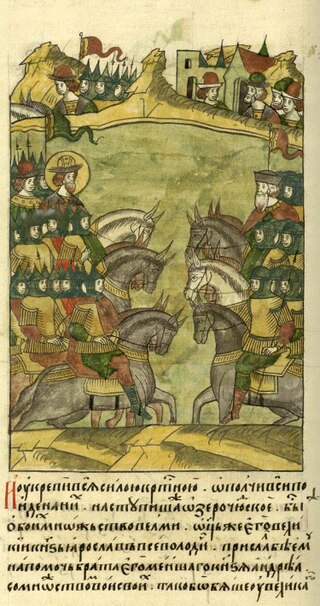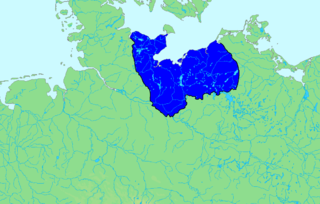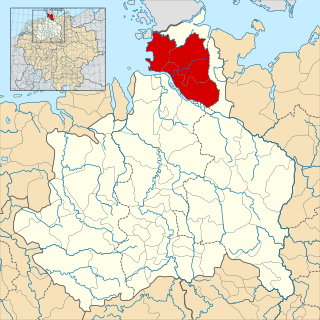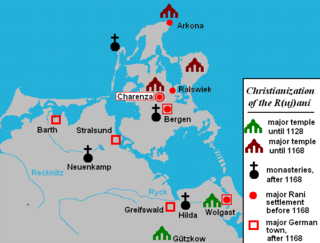Sources
- Thompson, James Westfall (1928). Feudal Germany, Volume II. New York: Frederick Ungar Publishing.
- Herrmann, Joachim (1970). Die Slawen in Deutschland. Berlin: Akademie-Verlag GmbH. p. 530.
The Battle of Schmilau (German : Schlacht bei Schmilau) was a battle between a coalition of Christian forces and pagan Slavic Obotrites in 1093.
Henry, a Christian Obotrite prince raised in Denmark after the murder of his father Gottschalk, avenged his father's death by killing the pagan Obotrite chief Kruto in 1093. The pagan Slavs rose up in rebellion against Henry's attempt to seize power.
Henry was supported by Duke Magnus of Saxony and a Danish contingent, while the pagans were led by Rochel, a Wagrian prince and pirate from the vicinity of Oldenburg. Henry was victorious in the battle at Schmilau, near Ratzeburg in eastern Holstein. The victory allowed Henry to consolidate the Obotrite realm and establish Liubice as his capital.

The Northern Crusades or Baltic Crusades were Christianization campaigns undertaken by Catholic Christian military orders and kingdoms, primarily against the pagan Baltic, Finnic and West Slavic peoples around the southern and eastern shores of the Baltic Sea, and also against Orthodox Christian East Slavs.

The Obotrites or Obodrites, also spelled Abodrites, were a confederation of medieval West Slavic tribes within the territory of modern Mecklenburg and Holstein in northern Germany. For decades, they were allies of Charlemagne in his wars against the Germanic Saxons and the Slavic Veleti. The Obotrites under Prince Thrasco defeated the Saxons in the Battle of Bornhöved (798). The still-Pagan Saxons were dispersed by the emperor, and the part of their former land in Holstein north of Elbe was awarded to the Obotrites in 804, as a reward for their victory. This however was soon reverted through an invasion of the Danes. The Obotrite regnal style was abolished in 1167, when Pribislav was restored to power by Duke Henry the Lion, as Prince of Mecklenburg, thereby founding the Germanized House of Mecklenburg.

Boleslaus I, a member of the Přemyslid dynasty, was ruler of the Duchy of Bohemia from 935 to his death. He is notorious for the murder of his elder brother Wenceslaus, through which he became duke.
Gottschalk, sometimes rendered as Godescalc, was a prince of the Obotrite confederacy from 1043 to 1066. He established a Polabian Slavic kingdom on the Elbe in the mid-11th century. His object in life seems to have been to collect the scattered tribes of the Slavs into one kingdom, and to make that kingdom Christian.

Polabian Slavs, also known as Elbe Slavs and more broadly as Wends, is a collective term applied to a number of Lechitic tribes who lived scattered along the Elbe river in what is today eastern Germany. The approximate territory stretched from the Baltic Sea in the north, the Saale and the Limes Saxoniae in the west, the Ore Mountains and the Western Sudetes in the south, and Poland in the east.
Thrasco was the Prince (knyaz) of the Obotrite confederation from 795 until his death in 810. He succeeded his father, Witzlaus II, who had been ambushed and killed by the revolting Saxons. Thrasco defeated the Saxons in the battle on Schwentine River in 798. He was murdered in Reric in 810. Thrasco had a son, Cedragus, the Obotrite prince from 819 to 826.
Berno, Bishop of Schwerin, also known as the Apostle of the Obotrites or Berno of Amelungsborn was a pre-eminent missionary to the Obotrites in the territory of Mecklenburg, Germany, and the first Bishop of Schwerin.

Nordalbingia was one of the four administrative regions of the medieval Duchy of Saxony, the others being Angria, Eastphalia, and Westphalia. The region's name is based on the Latin name Alba for the Elbe River and refers to an area predominantly located north of the Lower Elbe, roughly corresponding with the present-day Holstein region. Situated in what is now Northern Germany, this is the earliest known dominion of the Saxons.

Wartislaw I was the first historical ruler of the Duchy of Pomerania and the founder of the Griffin Dynasty.
The Wagri, Wagiri, or Wagrians were a tribe of Polabian Slavs inhabiting Wagria, or eastern Holstein in northern Germany, from the ninth to twelfth centuries. They were a constituent tribe of the Obodrite confederacy.
Kruto the Wend, son of Grin or Grinus, was a prince of Wagria. James Westfall Thompson believed his family belonged to the Rani of Rugia.
Henry was an Obotrite prince or king (1093–1127) from the Nakonid dynasty; he was regarded by contemporaries as "King of the Slavs". The Obotrite realm reached its greatest area during Henry's rule, extending from the Elbe to the Oder and from the Havelland to the Baltic Sea.

The Rani or Rujani were a West Slavic tribe based on the island of Rugia (Rügen) and the southwestern mainland across the Strelasund in what is today northeastern Germany.

Niklot or Nyklot was a chief or prince of the Slavic Obotrites and an ancestor of the House of Mecklenburg. He became chief of the Obotrite confederacy, including the Kissini and the Circipani, between the years 1130 and 1131. He remained in this position until his death in 1160. At the same time he was Lord of Schwerin, Quetzin and Malchow. For nearly 30 years he resisted Saxon princes, especially Henry the Lion during the Wendish Crusade.
The Nakonids were the leading noble family of the Slavic peoples of the Elbe River from ca. 960 until 1129. They were themselves of Obotrite origin and engineered the formation of a Slavic principality in the region. They became extinct in the male line in the early 12th century. Their capital was Mecklenburg Castle.

The Battle of Verchen was a battle between Saxons and West Slavic Obotrites on 6 July 1164.
Pribislav was an Obotrite prince and the first Prince of Mecklenburg (1167–1178).

Liubice, also known by the German name Alt-Lübeck, was a medieval West Slavic settlement near the site of modern Lübeck, Germany. Liubice was located at the confluence of the Schwartau with the Trave across from Teerhof Island, approximately four kilometres north of Lübeck's island old town. The residence of Henry, the Christian prince of the Obotrites, Liubice was destroyed after his death by the Rani pagans of Rugia.

Mecklenburg Castle was a medieval castle and a residential capital of the Nakonid and Nikloting dynasties of the Obotrites. It was located just south of the modern village Dorf Mecklenburg, seven kilometres south of the Bay of Wismar in Mecklenburg-Vorpommern, Germany. The only remnants of the ruined castle are parts of an earthen wall. Some scholars have associated Mecklenburg with the medieval trading emporium Reric.
Bucu or Buku is a hill island surrounded by the Trave and Wakenitz Rivers in Lübeck, Germany. It is also the name of a medieval Slavic castle, now ruined, on the island. Count Adolf II of Holstein founded Lübeck on the island in 1143. The Burgkloster, or fortified monastery, of Lübeck is located atop the ruins of Bucu. "Bucu" is also the name of a hill.